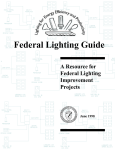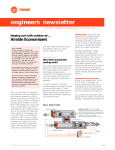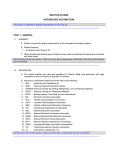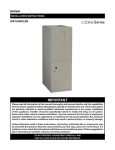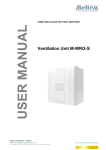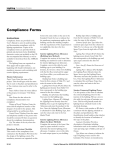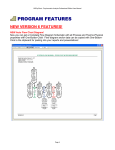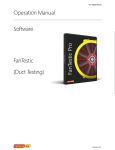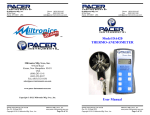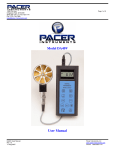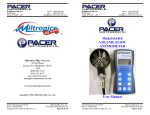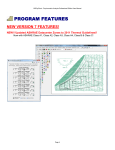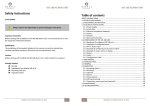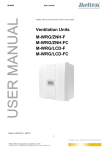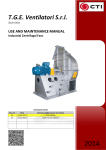Download Multizone Application of Solution Units
Transcript
MULTIZONE APPLICATION OF SOLUTION UNITS APPLICATION GUIDE Supersedes: 102.20-AG12 (206) GENERAL Multi-zone heating and air conditioning units offer design and application advantages over various smaller single zone machines. As a result, many consulting engineers have favored them for years. Multi-zone units are the ‘tried and true’ workhorse of the industry. The YORK Solution unit is designed to carry on that tradition by including a multi-zone (MZ) segment into the design of the unit. FUNDAMENTALS OF DELIVERY SYSTEMS All-air delivery systems are capable of heating, cooling, ventilation and dehumidification and provide a way of supplying conditioned air to the specific conditioned spaces or zones. When there is more than one zone to be served, there must be a means by which each zone has some control over the air-conditioning effect in that zone. Conditioned air can be supplied in one of two ways. A Single-path system can be used or a dual-path system. Single-path System Single-path systems configure the primary heating and cooling coils in a series flow path. The common duct used for air distribution supplies the single-zone with just one temperature control. This is the simplest type of all air systems. For this type of system to work properly, the load must be uniform all through the space, or else there may be a large temperature variation. Single zone systems are, in most cases, controlled by varying the quantity of chilled water or refrigerant, variable air volume, adding reheat, adjusting face or bypass dampers, or a combination of these. If humidity control is required while in the cooling mode, a reheat system must be used. Dual-path System Dual-path systems place the cooling coils and heating coils in separate ducts in which the air from the supply fan is split into two parallel paths, one for heating and the other for cooling. The two parallel paths provides for great flexibility in satisfying multiple loads and in providing prompt and opposite temperature response Form: 102.20-AG12 (307) as required. Dual path systems mix the hot and cold air at each zone at all times. A dual path system may be either a dual-duct system or a multi-zone system. These two systems are similar in thermal dynamics, how they affect temperature, pressure, volume, mechanical action, and function; they differ only in the physical layout of where the system mixes the air for each zone. DESIGN CONSIDERATIONS Possible Applications Multi-zone and Dual Deck air-handling units can be configured for heating and cooling, or cooling and ventilation, or ventilation and heating applications. The historical concept behind most MZ applications was to typically maintain 55° and 95° air at all times. As maintaining the hot deck proved expensive, especially in the southern regions where it is rarely used, the hot deck became a bypass deck. In cases where some heating was still required those zones received a heating coil. This development proved to be the most economical. The concept of bypass allowed a “dead band” between heating and cooling where the space is merely ventilated with blended return air and outside air. One of the more innovative implementations of this concept is in the use of the traditional hot-deck to supply neutral air from a dedicated outdoor air unit to the VAV boxes. Another variation of this strategy is referred to as the Texas multi-zone. Cooling Coils For the purposes of this discussion we will refer to cooling coils as ‘Chilled Water’ coils. The alternative would be to discuss both chilled water coils and direct expansion (DX) coils. Simply stated; DX coils applied in multi-zone systems can be very sophisticated. The selection of the coil, coil circuiting and the condenser should be reviewed with the system application for correct system operation. Potential risks with DX coil applications include but not limited to; low cooling load and compressor cycling, resulting in poor cold deck control and compressor failures. A special application review should be requested when a multi-zone DX cooling system is being considered. FORM: 102.20-AG12 (307) Characteristics of Dual Duct System Characteristics of Multi-zone System The dual-duct system, while maintaining a constant airflow, distributes air to the building through two separate ducts. Hot and cold ducts are extended into the occupied areas with mixing terminals for temperature control located over the conditioned spaces. The hot and cold air brought by the separate ducts to each zone is then mixed to meet the needs of the zone. • It is common for dual-duct systems to use high pressure air distribution systems with the pressure reduced in the mixing box at each zone. • A thermostat controls each zone in the system. The multi-zone system is a variation of the dual-duct system. The traditional multi-zone is a constant volume system that maintains room air changes, and space temperature and relative humidity with great precision. Dual-duct systems are used in larger buildings where it would be impractical to run a separate duct from the air-handler to each zone as is done in multi-zone systems. A simple dual-duct system is illustrated in the figure 1 below: The basic Multi-zone (MZ) unit consists of a supply air blower segment, a coil segment and discharge air elements. Other sections such as filters, air mixing boxes, access, and full economizer with a return/exhaust air blower is offered to customize the systems functional requirements. The unit discharge is available with multizone dampers or dual-duct openings either in horizontal or up-blast configurations. • Multi-zone systems use zone dampers, located at the air unit, to mix heated air from a heating coil and chilled air from a chilled water coil to regulate the air temperature for a space, or zone. EXHAUST AIR RELIEF DAMPER RETURN FAN CEILING PLENUM OR RETURN DUCT RETURN AIR MIXING BOXES (TYP) RETURN AIR DAMPER HEATING COIL OUTSIDE AIR DAMPER OUTSIDE AIR SUPPLY FAN COOLING COIL RETURN (TYP) ZONE 1 SUPPLY (TYP) ZONE 2 ZONE 3 Figure 1 – Basic Dual Duct Air Handling System 2 JOHNSON CONTROLS FORM: 102.20-AG12 (307) • The zone dampers, mixing air in proportions, keep the flow of mixed air to each zone approximately constant. • A zone thermostat controls each pair of zone dampers. • Each zone is designed to have a separate duct that extends all the way from the air-handling unit to the space. The MZ system is best suited for offices, schools and other similar buildings where a relatively small space requires independent zone thermostatic control. See figure 2. Multi-zone Dampers The MZ damper is a low-leak, vertical orientation, parallel blade damper. Each MZ damper assembly is made up of two dampers, one for the cold deck and one for the hot deck. The damper blades for the hot and cold decks are linked together and offset by 90°. Therefore, one actuator may operate the cold deck and hot deck simultaneously. As the damper opens one deck it closes the other, and vice versa. Each zone requires an actuator application. Therefore, calculate the torque required for each zone separately. The YORK Solution MZ damper has a constant height across its width. However, each zone may have a unique width. EXHAUST AIR Optional Manual Volume Damper CEILING PLENUM OR RETURN DUCT RELIEF DAMPER RETURN FAN RETURN AIR RETURN AIR DAMPER ZONE DAMPERS (TYP) HOT DECK HEATING COIL OUTSIDE AIR DAMPER OUTSIDE AIR SUPPLY (TYP) RETURN (TYP) SUPPLY FAN COLD DECK COOLING COIL ZONE 1 ZONE 2 ZONE 3 Figure 2 – Multizone Air Handling System—Only three zones are shown for clarity JOHNSON CONTROLS 3 FORM: 102.20-AG12 (307) SOLUTION MZ SEGMENTS A Multi-zone (MZ) segment is used to provide multiple discharge air-streams to specific building zones. • Each zone receives two discharge-air streams from the MZ. • One air-stream is defined as “cold” and the other as “hot.” • These air-streams are then mixed before entering the space. • The MZ damper controls the balance of “hot” and “cold” air to the space depending on the zone demand for heating or cooling. • The part of the MZ that supplies “cold” air is called the “cold deck,” and the part that supplies “hot” air is called the “hot deck.” Cold Deck Damper • The bottom tier is the cold deck and contains a diffuser or plenum, a chilled water coil and cold deck-zoning dampers. 1. When a DWDI fan is immediately upstream of the MZ, then the MZ must include a diffuser as the first section in the bottom tier of the MZ. 2. When the segment immediately upstream of the MZ is not a DWDI fan, then an access plenum will be the first section in the bottom tier of the MZ. • The top tier is the hot deck and contains a heating coil mounted horizontally (configured for vertical air flow) and hot deck-zoning dampers. • Air enters at the diffuser or plenum then splits into two streams. One stream turns up through the hot deck coil and exits the rear or top of the unit through the hot deck damper. See Figures 3 and 4. Cold Deck Damper Hot Deck Damper Hot Deck Damper HEATING COIL HOT DECK HOT DECK S1 XA HEATING OR COOLING COIL AIR FLOW ENTERING MZ RACEWAY RACEWAY HEATING OR COOLING COIL S1 VC VC DI^ RACEWAY RACEWAY Hot Deck Damper HEATING COIL HEATING COIL HOT DECK XA DI^ SIDE VIEW Figure 4 – Rear Discharge Flow w/Diffuser HEATING OR COOLING COIL RACEWAY RACEWAY AIR FLOW ENTERING MZ Cold Deck Damper HOT DECK HEATING OR COOLING COIL Cold Deck Damper XA Figure 5 – Top Discharge Flow w/o Diffuser RACEWAY RACEWAY Hot Deck Damper Figure 3 – Top Discharge Flow w/Diffuser 4 AIR FLOW ENTERING MZ SIDE VIEW SIDE VIEW VC* FH+.75 HEATING COIL RACEWAY FH+.75 INSULATED WALL RACEWAY RACEWAY RACEWAY INSULATED WALL 2.750 VC* AIR FLOW ENTERING MZ XA SIDE VIEW Figure 6 – Rear Discharge Flow w/o Diffuser JOHNSON CONTROLS FORM: 102.20-AG12 (307) • The other stream continues horizontally through the chilled water coil and exits the rear or top of the unit through the cold deck damper. 1. Air pressure drop balance plates are to be used to equalize pressure drop across the hot and cold deck coils when required. • When a DWDI fan is immediately upstream of the MZ, then the fan configuration shall be a horizontal inverted discharge. ANSI / ASHRAE / IESNA LIMITATIONS Increasing energy costs have limited the use of conventional MZ systems, which use more energy than certain single duct configurations when it is necessary to both heat and cool supply air and mix the airstreams to obtain the desired zone temperature and humidity. It is important to control MZ systems to limit simultaneous heating and cooling as much as possible. By far the largest opportunity for energy conservation in a multi-zone re-heat system is minimizing the mixing of hot and cold air. You can radically reduce energy losses by adjusting the discharge temperatures or supply air temperatures of the heating and chilled water coils. Automatic supply air temperature reset controls are available to maintain optimum temperatures. These methods are relatively inexpensive. However, we must mention the limitations placed on MZ systems by ANSI/ASHRAE/IESNA Standard 90.12004 – Energy Standard for Buildings Except Low-Rise Residential Buildings. These limitations can be found on page 38 of the 2004 Standard and 6-54 of the 2004 User’s Manual. Standard 90.1, per section (6.5.2.1), requires that zone thermostat controls must be capable of sequencing the supply of heating and cooling to each space. These controls must prevent; reheating, re-cooling, mixing or simultaneous supply of air that has been previously mechanically heated and air that has been previously cooled, either mechanical or by economizer systems, or other simultaneous operation of heating and cooling systems to the same zone. STANDARD 90.1 COMPLIANCE To comply with Standard 90.1-2004 (6.5.2.1), MZ systems must use one of the three exceptions as follows: 1. Simultaneous heating and cooling is allowed if it is minimized by limiting the airflow rate that is being reheated, re-cooled or mixed to a rate no greater than the larger of the following: JOHNSON CONTROLS a. The volume of outdoor air required to meet the ventilation requirements of standard 6.1.3 of ASHRAE. b. 0.4 cfm/ft2 of the zone conditioned floor area c. 30% of the zone design peak supply rate d. 300 CFM – this exception is for zones whose peak flow rate totals no more than 10% of the total fan system flow rate. e. Any higher rate that can demonstrated, to the satisfaction of the authority having jurisdiction, to reduce overall system annual energy usage by offsetting reheat/re-cool energy losses through a reduction in outdoor air intake in accordance with the multiple space requirements defined in ASHRAE Standard 62 2. Zones where special pressurization relationships, cross-contamination requirements, or code-required minimum circulation rates are such that variable air volume systems are impractical. 3. Zones where at least 75% of the energy for reheating or for providing warm air in mixing systems is provided from a site-recovered (including condenser heat) or site-solar energy source. DESIGNING TIPS The following should be taken into consideration when a multi-zone application is being considered: • Designers should include a manual opposed blade main volume damper near the unit to assist in air balancing. Air quantities delivered to the conditioned spaces will vary as the static pressure fluctuates with filter loading and conditions of the chilled water coil. • With designs containing a considerable number of zones, it is best to keep the zone duct static pressure low as possible to limit leakage. Maximum duct leakage should be around 2% of the zone supply air. (SMACNA leakage standard allows over 10%). • Periodically check the mixing dampers to insure that the mixing dampers are properly positioned and not blending air when full cooling or heating is required. • Specify low leak zone dampers. • Select areas of similar loads for a zone; don’t mix interior and exterior areas. • Locate the sensor or t-stat in the area of the zone and specify that the zone sensor be verified to control the proper zone. 5 FORM: 102.20-AG12 (307) MULTI-ZONE ADVANTAGES Multi-zone units offer the following advantages: • From a control standpoint the multi-zone is rather simple and inexpensive, there is little to go wrong. If you combine zone sensors, a mixing damper actuator for each zone, and cooling and heating valves, you have multi-zone control. • The simplicity of the multi-zone system includes minimum ceiling space requirements, uncomplicated installation, and has the control elements for mixing of the hot and cold air paths centrally located at the air-handling unit. • Since the multi-zone fan operates as a low static pressure system, it is quieter. Also, the fan is located mid position in the unit gaining fan outlet attenuation from the baffles, coils and casing. More importantly, the fan is not subject to any abnormal system effect, eliminating fan performance problems and the all too familiar rumble of a variable air system. Because it operates at a lower speed, the fan can typically be a Class I fan, which offers smooth operation and longer bearing and drive life. • The multi-zone will most certainly provide longevity with only minor maintenance and repairs. MULTI-ZONE DISADVANTAGES Some disadvantages of multi-zone units are: • When the need for many individual ducts is required, the number of zones could be limited • There is potential energy waste as well as high energy consumption due to the simultaneous heating and cooling of the air stream and inferior temperature control of the hot deck. • It can be very difficult to implement an economizer cycle • A multi-zone is generally custom selected and arranged for ‘fixed-functional’ needs ZONE SIZING The following example will use a multi-zone damper for a unit sized @ 10,000 CFM. This particular damper has 16 zones, each zone containing a 6" blade. The end zones for this specific damper will each be 8” wide. The inner zones will each be 6" wide for a total of 100". NOTE: Each end zone includes a 6" blade and a blank-off plate sized to fit the various cabinet sizes. See Figure 7. The total zone maximum CFM is 10,000 spread over 9 zones. The zones have the following CFM requirements: 700; 1,000; 2,500; 1,700; 500; 400; 400; 1,000; 2,000 CFM. 6 E= NO. OF 6" SPACES END ZONE D END ZONE 1.50 D DIVIDER BLADE BLANK-OFF PLATE BLANK-OFF PLATE Figure 7 – 16 - Zone Multi-zone Damper First determine the CFM per inch of damper length. 10,000/100" = 100 CFM/in. Therefore, the ideal CFM for the 8" zone sections is 800 CFM, and 600 CFM for the 6" zone sections. • The first zone requires 700 CFM. The first blade’s ideal CFM is 800. Assign the first zone to the first blade. • The next zone requires 1,000 CFM. The next two blades’ ideal CFM totals 1,200. Assign the next zone to the next two blades. Continue until the second to last zone has been defined. Zone assignments will be as follows: 1 2 8" 700 6" 6" 1000 3 6" 6" 6" 2500 4 6" 6" 5 6 7 8 9 6" 6" 6" 6" 6" 6" 6" 8" 1700 500 400 400 1000 1800 • The final zone needs 1,800 CFM but the ideal CFM for the last available blade is only 800. The last zone needs 20" of damper width to be properly sized. Therefore, we must take two 6" damper blades from a previous zone and “give” it to the last zone. Zones 1, 5, 6, and 7 have only one blade each and therefore cannot be made smaller. Zones 2, 3, 4, and 8 have more than one blade. Therefore, we will examine the impact of subtracting a blade from each of these zones. Zone two has an ideal CFM of 1,200, and actual CFM of 1,000 – a difference of 200 CFM. If we subtract a blade, it will have an ideal CFM of 600 and an actual CFM of 1,000 – a difference of 400 CFM. The ratio of this difference to the actual CFM is 400/1000, or 0.4. We do the same calculation for zones 3, 4 and 8, yielding impact ratios of 0.28, 0.29, and 0.4, respectively. Zones 3 and 4 have the smallest impact ratios. Therefore we could take one 6" blade from each zone. However, if you only “steal” one blade from either zone 3 or 4, then zone 9 has an ideal CFM of 1400 and an actual CFM of 1800 for a difference of 400, which equals an impact ratio of 0.22 – less than the impact ratio of stealing a blade from 3 & 4. JOHNSON CONTROLS FORM: 102.20-AG12 (307) (these items are typically shipped loose with each air handler). Next, consult the job specifications and submittal drawings for specific zoning requirements, connection requirements, and location. It is essential that, prior to performing any task on this equipment, the individual responsible for installation, shall have read and understood all the equipment documentation and installation instructions, shipped with each unit, for assembling. HOT DECK COLD DECK Figure 8 – Multizone Controlled Dampers REFERENCES NOTE: For more information, please reference: Air handling Unit Installation Instructions Form 102.20-N1. “Fundamentals of HVAC Systems” chapter 9 & 10, Richard R. Johnson, Ph.D., ASHRAE Society of Heating, Refrigeration and Air-Conditioning Engineers Inc. The final zoning arrangement is: 1 2 8" 700 6" 6" 1000 3 6" 6" 6" 2500 4 6" 5 6 7 8 6" 6" 6" 6" 6" 6" 6" 1700 500 400 400 1000 9 6" 8" 1800 CONTRACTOR RESPONSIBILITY The individual responsible for the final connection of the zoning ducts to the zone dampers should, before installing the zone-ducts to the damper, check each set of damper blades to make sure that the blades are 90 degrees apart. Rotate the dampers to make sure that no binding occurs. Check all of the damper rods, clips and screws to make sure that all are tight. Locate and secure the extended shaft kits and couplers for each damper JOHNSON CONTROLS “Air Conditioning Design Manual”, chapter 6, ASHRAE 581-RP Project Team, 1993 American Society of Heating, Refrigerating and Air-Conditioning Engineers, Inc. ASHRAE. 2004. ANSI/ASHRAE/IESNA Standard 90.1 – 2004 Energy Standard for Buildings Except Low-Rise Residential Buildings. Atlanta, GA: American Society of Heating, Refrigerating and Air-Conditioning Engineers, Inc. ASHRAE 2004. ASHRAE Standard 90.1 User’s Manual, chapter 6. Atlanta, GA: American Society of Heating, Refrigerating and Air-Conditioning Engineers, Inc. 7 P.O. Box 1592, York, Pennsylvania USA 17405-1592 © by Johnson Controls 2006 Form 102.20-AG12 (307) Supersedes: 102.20-AG12 (206) Tele. 800-861-1001 www.york.com Subject to change without notice. Printed in USA ALL RIGHTS RESERVED








